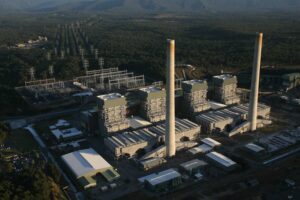
The spectacular falls in the cost of wind and solar energy continued in 2017, dropping another 18 per cent across the globe, according to the latest report from Bloomberg New Energy Finance.
The report also highlights the falling cost and growing uptake of battery storage, which together are mounting an unprecedented challenge to fossil fuel power, particularly as batteries start to encroach on the flexibility and peaking revenues enjoyed by those fossil fuel plants.
The new report from BNEF highlights Australia as one of the key countries to have led the cost reductions in both wind and solar. India is also cited for both wind and solar.
“Coal and gas are facing a mounting threat to their position in the world’s electricity generation mix, as a result of the spectacular reductions in cost not just for wind and solar technologies, but also for batteries,” the BNEF report says.
It notes that the cost of solar has fallen by 77 per cent to a benchmark global average of $70/MWh over the last seven years, while the cost of wind has fallen 38 per cent to a benchmark global average of $US55/MWh.
The benchmark price for lithium-ion batteries has also fallen nearly 80 per cent from $US1,000 per kWh in 2010 to $US209/kWh in 2017.
To be sure, there are countries where the cost of wind and solar is significantly cheaper than this, but it is interesting to note that these correspond roughly to the cost of wind and solar in Australia – if the $A was substituted for the $US calculation.
“Our team has looked closely at the impact of the 79 per cent decrease seen in lithium-ion battery costs since 2010 on the economics of this storage technology in different parts of the electricity system,” says Elena Giannakopoulou, head of energy economics at BNEF.
“Some existing coal and gas power stations, with sunk capital costs, will continue to have a role for many years, doing a combination of bulk generation and balancing, as wind and solar penetration increase.
“But the economic case for building new coal and gas capacity is crumbling, as batteries start to encroach on the flexibility and peaking revenues enjoyed by fossil fuel plants.”
The BNEF report says that fossil fuel power is now facing an unprecedented challenge in all three roles it performs in the energy mix – the supply of ‘bulk generation’, the supply of ‘dispatchable generation’, and the provision of ‘flexibility’.
In bulk generation, as energy authorities in Australia have long recognised, the threat comes from wind and solar photovoltaics, both of which have reduced their LCOEs further in the last year, thanks to falling capital costs, improving efficiency and the spread of competitive auctions around the world.
In dispatchable power – the ability to respond to grid requests to ramp electricity generation up or down at any time of day – the challenge to new coal and gas is coming from the pairing of battery storage with wind and solar, enabling the latter two ‘variable’ sources to smooth output, and if necessary, shift the timing of supply.
In flexibility – the ability to switch on and off in response to grid electricity shortfalls and surpluses over periods of hours – stand-alone batteries are increasingly cost-effective and are starting to compete on price with open-cycle gas plants, and with other options such as pumped hydro.
BNEF’s calculations for LCOE for wind, solar and storage take into account equipment, construction and financing costs, as well as maintenance expenses and average running hours.
It noted that in India, where Australian conservatives continue to try to justify new coal mines such as Adani’s Carmichael project on the basis that coal is cheaper, wind and solar are winning out easily after spectacular falls in the past year, well beyond the global average.
The BNEF index is now showing benchmark LCOEs for onshore wind in India of just $US39/MWh, down 46 per cent on a year ago, and for solar PV at $US41/MWh, down 45 per cent.
By comparison, coal comes in at $US68 per MWh, and combined-cycle gas at $US93/MWh. Wind-plus-battery and solar-plus-battery systems in India have wide cost ranges, of $34-208/MWh and $47-308/MWh respectively, depending on project characteristics, but the center of those ranges is falling fast.
Seb Henbest, head of Europe, Middle East and Africa for BNEF, says the cost falls have been driven by competitive auctions for new renewable energy capacity.
“Thanks to this and to progressively more efficient technology, we are seeing record-low prices being set for wind and solar, and then those records being broken again and again on a regular basis. This is having a powerful effect – it is changing perceptions.”








